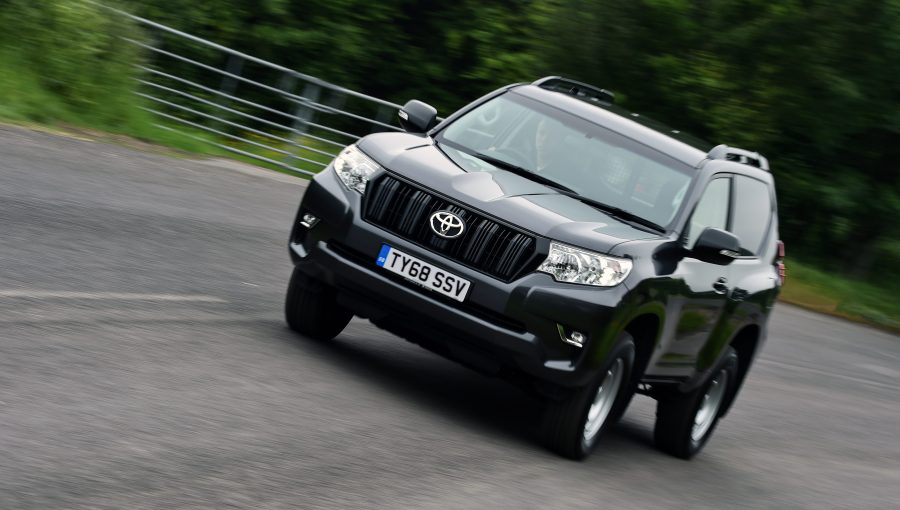Although Toyota’s passenger car range is predominantly focused around petrol-electric hybrid powertrains, the Land Cruiser, Hilux and Proace models are fitted with diesel engines. A diesel particulate filter (DPF) is a feature of these models, and you may have heard about the need for regular DPF regeneration. What does this component do and how do you take care of it?
What does a diesel particulate filter (DPF) do?
The DPF is fitted within the exhaust system and is designed to catch soot particles and nitrous oxide (NOx) from the combustion process that would otherwise be released into the atmosphere. The DPF is highly effective and traps around 80% of these harmful particulates.

Why do modern diesel engines need a DPF?
European legislation places strict exhaust emissions targets on all vehicle manufacturers. From September 2009, the Euro 5 legislative standard came into effect, part of which required all diesel cars registered from that point on to be equipped with a diesel particulate filter, or DPF.
These filters are used throughout the industry in all diesel-powered passenger vehicles, and their efficiency is vital now that stringent Euro 6d emissions standards are in force.
Do I need to replace a DPF during normal servicing?
Diesel particulate filters do have a capacity limit and can become full. But unlike traditional air, oil or pollen filters that need to be exchanged manually at regular intervals, the DPF has a much longer service life and is designed to regenerate to restore its performance.
The car’s electronic control unit (ECU) is programmed to do this automatically, neutralising the soot by burning it off at high temperature within the exhaust system while the vehicle is running. All modern cars with diesel engines follow this procedure.

How does DPF regeneration occur?
The regeneration occurs automatically, usually without the driver being aware that it is taking place. In the majority of cases, the process is carried out when the engine and exhaust system has reached normal operating temperature and the vehicle is travelling at over 40mph.
However, if your driving is limited to urban areas, the low speeds and frequent stops mean the conditions for normal regeneration do not exist. In these instances, the ECU monitors the accumulation of soot and instructs an alternative regeneration programme to begin well before the filter becomes saturated.
This programme injects small quantities of fuel into the engine after combustion, which increases the temperature within the exhaust system and creates an environment where it is possible to safely burn off the soot.
This method is very successful within the small percentage of vehicles where normal regeneration is not possible. However, due to the nature of city traffic, the regeneration process can be interrupted when the vehicle completes its short journey and is turned off. If this occurs, the ECU is programmed to recommence the process when the engine is restarted and back up to temperature again.

How can I help prevent DPF blockages in my Toyota?
Follow these four simple actions:
1. Regularly drive your Toyota on highways at speeds of between 40-55mph for around 20-30 minutes.
2. Avoid spending unnecessary amounts of time with the engine idling.
3, Try to limit the frequency of short journeys where the engine is running for less than ten minutes.
4. Do not ignore dashboard alerts related to the DPF.
Will I be warned if all DPF regeneration processes have been unsuccessful?
Very occasionally, use of the vehicle might be such that it will have been impossible for the ECU to complete the administration of any regeneration procedure. At this point, the DPF will have become overloaded and stopped functioning, so your Toyota will illuminate a warning light in the dashboard. It will then be necessary for the soot to be neutralised and the filter regenerated manually at a main dealer.
It is extremely unwise to ignore this visual warning as the DPF can become irreparably damaged. What’s more, it is illegal to remove the filter entirely.
Learn more: What is the exhaust gas recirculation valve and what does it do?





Hi, my 2014 yaris icon 1.4L has suddenly dropped in mpg over the past 3 months – after a good ~2 years of 450-500 miles per tank, I am now struggling to get 400 miles per full tank. I commute to work and regularly drive 50+ miles per day with at least 40 minutes above 40 mph (including a couple of stretches at 70mph). Can you advise why my mpg has dropped? Could this be a problem with the dpf/ECU? Thanks.
Hi Tanja,
Thank you for your post. Due to many factors which may contribute towards this, we will find this hard to advise online. Therefore we would advise visiting your local Toyota dealer who will be able to take a visual check of your can and be able to advise accordingly. Your local Toyota dealer can be found here: https://www.toyota.co.uk/world-of-toyota/find-your-dealer.json. Hope this helps and if you have any other questions please let us know.
I have a 2014 Yaris diesel with 79k miles which I use for driving tuition.
The car ran perfectly for 40k then the EML came on and I took it to the dealer who did a software update and a regen on the DPF.
It ran great for another 20k as far as I can remember, with the DPF warning light coming on a few times and as recommended taking it up the motorway for a good 30 minute run at 70 in 4th gear cleared it.
From then and especially from 70k this has been happening more frequently and recently the DPF light has not been coming on just going straight to limp home mode with the EPL light on.
the dealer has been doing regens but the last one only lasted 150 miles.
I’m at my wits end as i have tests coming up and cannot rely on the car.
The dealer says the filter is fine because it is regenning ok but i need some advice as to when you know when a filter has reached the end of its life and a new one should be fitted?
Having exactly the same issue now 2013 model at 64k, it’s at the the dealer now getting fixed hopefully but not a reliable car for driving instructors.
Hi, im Ardy.. I have trouble with my land cruiser VDJ200. The display in meter combination is “DPF FULL SEE OWNERS MANUAL”. I have been removed it with the new one but the trouble was not clear. So what i have to do next? Thank you very much
Hi Sunardi. We recommend you visit your local Toyota dealer to inspect the vehicle. Thank you.
In my car meter showing dpf full and p244c dtc showing in trouble code. but we cant solve the problem any procedur available for this dtc.
Hi Ravish,
Thank you for your post. We would advise visiting your local Toyota Dealer who will be able to look into this issue further. Your local Toyota dealer can be found here: https://www.toyota.co.uk/find-your-dealer.json. Many thanks.
I’ve been driving a Yaris diesel bought new 3 years ago and have been told the DPF filter needs replacing for over £1,000 and isn’t covered under warranty. The dealer told me it used to be covered but was withdrawn as there was so many faults coming in. They also told me that I was the fourth person with the issue that week, so it’s endemic.
This seems like a big fault with Toyota Diesels that should have been highlighted to buyers from Toyota , so what would be the best trade or legislative body to raise this to in the UK? I’m at the stage where I don’t trust Toyota’s or the warranties any more.
FYI: I drive on a dual carriageway at 70 mph twice a day, so the regen should be working- but isn’t clearly.
Hi Tim,
Thank you for your post. We are sorry to hear about the issues you are experiencing. We would advise contacting our customer relations team here: po.st/fH3m6j. Many thanks.
HOW TO KNOW IF MY CAR IS EQUIPPED WITH DPF OR NOT?
MY CAR VIN IS: JTMBA31V90D006549
Hi Ibra,
Thanks for you post. I have spoken with our technical team and our system is showing that your vehicle does not have DPF. Hope this helps. Many thanks.
I’m also trying to find out if my avensis has a dpf
chassis. sb1ba76l70e004005
engine. 2af5442219
Hi there,
Thanks for your post. The answer to your query is, Yes. Your Avensis does have a DPF fitted. Many thanks!
I recently purchased a new Toyota Avensis 2.0 143ps D4D, Toyota’s reputation for reliability was the deciding factor. My driving pattern is a 5 mile each way commute to work, shorter local journeys on the weekends, approximately 10 longer journeys of over 300 miles annually, and a summer holiday involving approximately 2,000 miles on French roads. Total 8,000 miles per year just about every year. The vehicle is serviced by Toyota at the recommended intervals and fuelled with Shell diesel. In view of what I have read about DPF problems I am concerned that I may have purchased the incorrect car. My previous vehicle, an Audi petrol covered 120,000 miles over 12 years of ownership without any special maintenance other than regular servicing, I expect the same from my new Avensis, an unreliable or troublesome car is not acceptable in year 2016.
Some questions:
1. What is the likelihood of DPF problems, and how frequent is blockage expected to occur?
2. What steps can I take to mitigate any filter blockage?
3. Is use of a fuel additive which lowers the temperature at which soot is combusted in the DPF recommended by Toyota?
4. If so, how often is the additive to be added, to each tank, or less frequently?
5. Do more frequent oil changes, perhaps every 5,000 miles help reduce the possibility of DPF issues?
6. Assuming a careful driving style and the above describes mileage what is the anticipated minimum mileage at which the DPF will need to be replaced?
7. What is the current cost of replacing the DPF on a 2015 Avensis 2.0 143ps D4D at aToyota dealer?
Please provide honest and open answers to all my questions, I can live with swooping this car for a petrol or hybrid vehicle, however as I live in the country and full time availability of my vehicle is essential, a car which needs ongoing additional maintenance and may leave me stranded due to a blocked DPF is unacceptable.
Best regards,
Ross